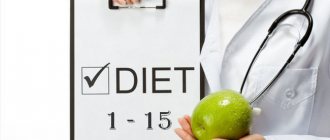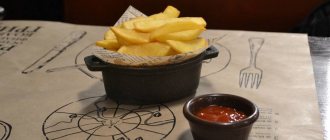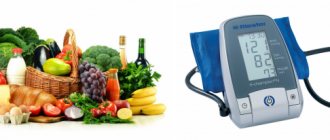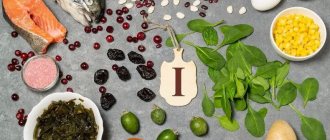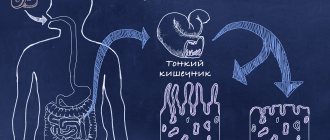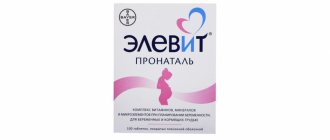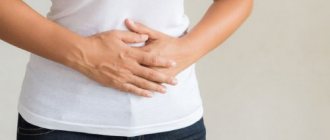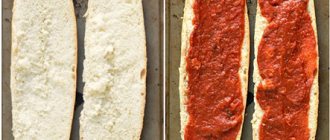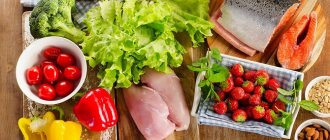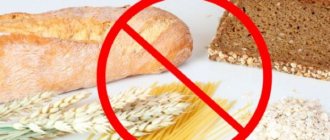Today you can often hear the name “gluten-free diet”. In one context, there is talk of a fashionable trend to give up gluten, and people often don’t even fully understand why it’s worth doing. In another version, the combination “gluten-free diet” is pronounced by doctors as a recommendation for restorative nutrition in the case when a patient suffers from intolerance to a particular type of protein. Well, in some cases, people give up foods containing gluten in order to improve their body health and get as close as possible to the ideal formula for preserving vitality and health.
But what exactly is a gluten-free diet, and what does avoiding gluten-containing foods do for the body? Let's try to consider this topic in detail.
The importance of diets. A little research
Gluten or gluten is a protein that has the ability to stick together. The largest amount of the element can be found in wheat, also in pasta, meat products and dairy products. You can see a more complete list.
Gluten is also added as a preservative to various products to increase the shelf life of products. In addition, the US Food and Drug Administration (FDA) allows small amounts of gluten in gluten-free products.
Often, even in childhood, many children experience intolerance to the substance. This is explained by the fact that the child’s body does not have enough enzyme that hydrolyzes the protein completely (breaks down the molecules of the substance into amino acids). With age, the disease can go away or develop into an allergy to gluten and a more serious disease - celiac disease.
People who experience problems after taking gluten must know gluten-free foods to protect their health. And for some, a gluten-free diet is the only chance to live a full life.
Dozens of studies have not answered the question of how much of a substance consumed can be safe for human health. Some experts suggest that 620 mg per day (about one-fifth of a piece of bread) is quite acceptable, while other scientists argue that even 10 mg of gluten per day can have serious consequences.
This is due to the fact that in people with celiac disease, every time they eat foods with gluten, the amount of gluten in the body accumulates, which leads to a worsening of the patient's condition. As a result, intestinal villi develop atrophy.
Scientists at the University of Maryland found that in patients whose diet included 50 mg of gluten daily, villous atrophy was observed as early as 90 days. 10 mg of gluten showed the lowest percentage of disease development.
advertising is not displayed
Thus, according to preliminary data from experts from the USA, we can conclude that the maximum amount of protein intake for patients with celiac disease and for people with gluten allergies is 10 mg per day. However, this indicator is individual for each person.
It is important for patients to know which gluten-free foods they can eat. In addition, they should consult a doctor so that he can prescribe the correct diet based on test data
Doctors' opinion
Recently, demand for gluten-free products has increased by 12%. In developed countries, 30% of the adult population consciously stopped consuming gluten-containing foods. Global trends reach Russia slowly. There are opponents and supporters of the program. Experts' opinions were divided.
Khandrimailo Victoria Aleksandrovna, nutritionist
“If you have allergies, a gluten-free diet is not suitable for everyone. Thoughtless exclusion of gluten-containing foods from the diet leads to disruption of metabolic processes. The functioning of internal organs and their cognitive functions are disrupted. Slow carbohydrates must enter the body, since they are the source of energy. You just need to make sure that the amount of energy received is no more than the energy wasted. Fat cells accumulate if energy is not used. Moderate physical activity is required. They improve blood circulation, accelerate metabolic processes, and saturate cells with oxygen.”
Candidate of Medical Sciences Petrov Yuri Dmitrievich
“The public’s enthusiasm for the gluten-free diet is nothing more than a fashion trend that will soon cease to exist. In civilized countries, many restaurants have a list of gluten-free dishes on their menus. But in this case, it would also be correct to provide a list of dishes for diabetics, people with protein intolerance, etc. Research by scientists at Harvard University has proven that a special dietary program does not prevent cardiovascular diseases. That is, it should not be used by people who do not have a diagnosis of celiac disease.
In medical circles, only among laymen there is an opinion that gluten contributes to the development of obesity and is the cause of cardiovascular diseases. After the publication of unconfirmed information, the diet became very popular among the general public. Of course, there were people who wanted to make extra money from this. Many manufacturers produce products labeled gluten-free.
Maksimov Igor Leonidovich
“A gluten-free diet by itself does not promote weight loss. Prolonged adherence to a special program disrupts the natural processes in the body. Dangerous side effects occur. For quick, effective weight loss, you need not to exclude foods containing gluten, but to limit the consumption of harmful carbohydrates. That is, buns made from white flour should not be eaten not because they contain gluten, but because they contain a lot of quickly digested carbohydrates that easily turn into fats. At the same time, eating oatmeal and durum pasta has a beneficial effect on the body.”
Experts have come to the conclusion that it is not worth excluding products containing gluten from the diet if there is no indication for it. The presence of gluten in a product does not mean that the product is dangerous and should not be purchased. However, there is nothing dangerous in the technique. If a weight loss course lasts 1-4 weeks, body weight actually decreases and health improves.
The benefits of gluten-free foods
According to modern nutritionists, gluten is one of the types of food allergens that force the immune system of some people to fight them intensively. Since gluten enters the body through the stomach, it first disrupts the normal functioning of digestion and absorption of nutrients, gradually reducing immunity. Avoiding gluten-containing foods helps restore your health.
However, as with other food allergens (such as lactose and milk allergies), the problem is not the food allergens, but the body's overreaction. Just because one person has a gluten allergy does not mean that another person who is completely healthy will experience positive health benefits by completely avoiding gluten-containing foods.
Gluten-free diet and digestion
On the other hand, there are scientific studies that limiting the consumption of foods containing gluten has a positive effect on the state of the gastrointestinal tract and immunity, even in the absence of intolerance to this substance. We are talking, first of all, about reducing the level of various micro-inflammations and increasing the number of beneficial digestive bacteria.
Perhaps the benefit of eating gluten-free is that a diet based on all kinds of vegetables is an example of a prebiotic diet. Let us recall that prebiotics are food components that are not digested or absorbed in the upper gastrointestinal tract, but are fermented by the microflora of the human large intestine and stimulate its growth and vital activity.
***
The direct positive effect of a gluten-free diet will only be observed in those few people whose bodies are truly gluten intolerant. However, without a doubt, giving up gluten in the form of baked goods, white bread, pizza and other “empty calories” will definitely be useful for normalizing weight in a completely healthy person.
- Gluten free diet, source
- History of gluten and its effects on celiac disease, source
- Gluten-Free Diet: Gaps and Needs for a Healthier Diet, source
Material rating:
Gluten-free diet - list of gluten-free foods,
3.52 / 93
You need to enable JavaScript to vote
Reviews and results
Eliminating gluten-containing foods from the diet of patients leads to rapid disappearance of symptoms. The first sign is the disappearance of frequent and profuse stools and allergic rashes. For patients, this is the only treatment and opportunity to eat and live normally. Often this diet becomes popular among people who want to lose weight. This makes sense - it does not harm health, during its stay the body gets rid of gluten breakdown products, the intestinal villi are cleansed and digestion improves.
Reviews of a gluten-free diet for weight loss indicate that weight loss averages 2.5 kg per week, and then slows down somewhat. It promotes the elimination of toxins, so vigor and lightness in the intestines appear, and stool normalizes. At least, it’s not so much weight loss, but overall condition and health improving. The diet does not involve fasting; only baked goods, pasta, and some cereals are excluded; sugar and salt are limited.
- “... I tried to lose weight on this diet. There was no amazing weight loss - 4 kg in 3 months. But the diet is easy to tolerate; I think it’s just a normal diet. The weight loss was, in my opinion, due to the fact that I did not eat sweets, chocolate, cookies, cakes and pastries. I baked bread for myself instead of bread and for a snack, but it was impossible to eat a lot of them. It was summer, so I ate vegetables unlimitedly, but I didn’t want the allowed cereals (or I ate very little). In general, a healthy diet, considering that I boiled or baked all the meat and ate a lot of vegetables. I hope that the intestines are cleansed. The condition has improved significantly. For the “purity” of the experiment, it was necessary to check the cholesterol before and after”;
- “... I heard the opinion that you need to give up gluten after 40 years to maintain normal health. At the same time, many are still losing weight. I decided to try it too. Moreover, there is a bread machine in which you can bake gluten-free bread. Giving up some cereals and pasta is not a problem. It was more difficult to give up cakes, pastries, waffles and delicious cookies. The bread I prepared could not be compared with them, even smeared with honey or homemade jam. But once I got down to business, I decided to see it through to the end. The second motive was that there were problems with digestion (gas, rumbling, constipation, heartburn). My results for 3 months are as follows: minus 4.5 kg, problems with the gastrointestinal tract went away, the skin became clearer and without rashes, more energy, and the headache stopped. I am very pleased";
- “... I suffer from chronic enterocolitis, with exacerbation the pain in the intestines intensifies and loose stools appear, I can’t eat fruit at all in the summer, I also can’t tolerate milk well. Previously, I used Diet No. 4 all the time, but the last time the department checked my gluten tolerance and revealed a high titer of antibodies. This turns out to be the reason. A gluten-free diet was prescribed and after only 3 weeks of strict adherence to it, significant improvements appeared. The doctor said that in order to completely remove allergens and toxins, you need to follow it for 4 months or more”;
- “... They prescribed it to a child, and it turned out that there was nothing particularly difficult or impossible about it. After two months, we re-tested and the gluten titers decreased. Within four months, the child’s stool returned to normal, and bloating, fermentation, and foul-smelling feces disappeared. The symptoms of atopic dermatitis also disappeared. I’m very pleased with the result, it’s a pity that none of the doctors suggested it earlier.”
What you can and cannot eat on a gluten and dairy-free diet
Before you go on a gluten-free and dairy-free diet, you need to familiarize yourself with the list of allowed and prohibited foods. Only then, based on the information received, can you choose a suitable diet for yourself.
List of allowed foods on a gluten-free diet
To lose weight on a gluten-free diet, you need to keep the following products in your diet:
- from cereals - rice, buckwheat, millet and corn;
- olive or sunflower oil;
- fish and meat;
- leaf tea;
- eggs;
- potato;
- fresh vegetables (you can bake them in the oven or boil them);
- legumes;
- nuts or artichokes;
- lactose-free milk (soy or plant-based);
- berries.
List of prohibited foods
In addition to barley, wheat and other cereals, the following foods are prohibited:
- dairy products (ice cream, yogurt, kefir);
- semi-finished products (dumplings, sausages, sausages);
- crab and fish sticks;
- blue cheeses;
- canned fish;
- canned fruits and vegetables;
- kvass, beer;
- coffee, tea bags, cocoa;
- sweets (caramels, candies, marmalade, jam);
- chips, crackers, corn sticks;
- jam, sauce, mayonnaise, ketchup;
- soy products;
- cereals and other breakfast cereals;
- pastries, bread;
- pasta;
- semolina.
How to replace bread
Based on the permitted list of gluten-free food products, we can conclude that flour is strictly prohibited. Many diets allow the consumption of rye or whole grain bread, but in this case, such baked goods are prohibited, since rye and wheat are at the very top of the list of “What not to eat” in an anti-gluten regime.
Note! There is an option to replace regular bread: bake it from gluten-free flour. Buckwheat, rice or corn flour is used for this.
True, such baked goods are not very fluffy and crumble due to the lack of gluten in them.
Potato flour
Potato flour is rich in vitamin B and fiber. Do not confuse it with starch; when preparing flour, it is specially decanted. It is suitable for preparing moist baked goods - bread, pancakes and waffles, as well as pureed soups and sauces. Cut raw potatoes into large pieces and puree in a powerful blender until liquid. Place in thick gauze and squeeze to strain out the starch. Place the resulting mixture on baking paper and place in a dehydrator overnight. In the morning, grind the dry mass again in a blender, sift through a sieve and store in the refrigerator for up to 3 months.
List of prohibited products
Gluten can be obvious or hidden. In the first case, the list of prohibited foods is small and consists of only four grains. They cannot be consumed unchanged or processed. We are talking about cereals, porridges, flour, and baked goods.
Prohibited products:
- wheat;
- oats;
- barley;
- rye.
The situation with hidden gluten is much more complicated. It can be contained in any product. When choosing ready-made dishes, semi-finished products, sauces, you need to carefully study the composition. There may be no gluten in the cutlet itself, but it is contained in the breadcrumbs that cover the meat product. It is often found in ice cream, sausages, candies, breakfast cereals, and beer. Careless manufacturers add grains to coffee and cocoa to reduce the cost of products and increase profitability.
Important! Gluten is found not only in food, but also in medicines, vitamin preparations, and is found in dietary supplements. The only advantage is the transparency of the instructions; usually contraindications include celiac disease or gluten intolerance
How does gluten intolerance manifest?
Celiac disease usually occurs in childhood. Most often this manifests itself during the introduction of porridge into complementary foods at the age of about 6-7 months. Sometimes gluten intolerance can manifest itself later under the influence of various factors, for example, ARVI or intestinal infection.
Typical symptoms of gluten intolerance include:
- mushy grayish stool;
- sudden weight loss;
- bloating and increase in abdominal circumference;
- difficulties with the development of psychomotor skills.
The symptoms of celiac disease are similar to those of other diseases, so it can be difficult to diagnose. Frequent consequences of developing gluten intolerance:
- Deterioration of absorption of vitamins and microelements. At the same time, vitamin D and calcium are absorbed worst of all. This leads to the development of osteoporosis and rickets.
- Deterioration of lipid and carbohydrate metabolism. Causes energy metabolism disorders, polyhypovitaminosis.
- Lactase deficiency as a possible consequence. Accompanied by bloating, copious sour stools of foamy consistency.
List of allowed foods for children on a gluten-free diet
Creating a diet for a child with gluten intolerance is a very important and primary task for the mother. She needs to understand that now her child will not be able to eat food that is familiar to many children for the rest of his life.
Don’t focus your baby’s attention on this! It is enough just to gradually instill in him the right habits. Then he will perceive his diet as simply normal nutrition.
Authorized products:
- Various soups with meat or fish broth. Any type of meat or poultry is suitable for making soups. It is better for kids to choose chicken or turkey, for older children - veal or lean pork. You can add vegetables or cooked grains that do not contain gluten (for example, corn or rice) to the soup.
- Porridges that do not contain gluten. Kids can cook buckwheat dishes. Corn or rice porridge is perfect. If desired, you can add a little milk, but it is better if diluted with water. Dilute milk in a ratio of 1:1 or 1:2.
- Any fermented milk products.
- Meat or chicken (in any form). In this case, only the age of the child should be taken into account.
- All fruits and vegetables.
- Steam omelet or hard-boiled eggs. Eggs can be added when preparing various dishes.
- Tea, cocoa, various fruit drinks and compotes.
- You can include various industrially produced versions of gluten-free bread, baked goods, and pasta in your diet.
- Flower or linden honey.
- Various oils: vegetable or butter.
Gluten allergy
An allergic reaction to gluten is quite rare and is caused by the following reasons:
- reduced immunity;
- disorders of the gastrointestinal tract;
- negative external factors - poor lifestyle, infections, viruses and environmental conditions.
The disease can be detected through tests. It is worth paying attention to an increase in alkaline phosphatase levels, a decrease in cholesterol, and an increase in albumin.
These indicators reflect problems with the liver, kidneys, bone and muscle tissue disorders. The patient's body is at risk of developing stomatitis and arthritis - this is evidenced by inflammation of the internal organs. Protein intolerance negatively affects the brain and its blood supply, causing migraines and neuralgia.
Orange cupcake
Another tasty, healthy and easy-to-prepare sweet that can be included in the gluten-free diet menu. You will need:
- rice flour – 170 g;
- cane sugar – 100 g;
- chicken eggs – 2 pcs.;
- butter – 150 g;
- salt – 1 pinch;
- baking powder – 1 tsp;
- dried cranberries – 40 g;
- orange – 1 pc.;
- cognac – 2 tbsp. l.
First you need to extract 1 tbsp from the orange. zest and 30 ml juice. Then pour the cognac over the cranberries. Beat butter with sugar, add yolks, and then flour. Pour in orange juice with zest, as well as already softened cranberries. Beat the whites into a foam with salt, mix the resulting mass into the dough. Definitely in 3-4 doses! The dough should be fluffy and thick.
Pour the mixture into a mold, smooth it out, and then put it in the oven, preheated to 180°C. Bake for half an hour, maybe a little more. Then cool and sprinkle with powdered sugar. You can add glaze and decorate as you wish.
Best Gluten Replacement Products
While gluten improves the taste and appearance of foods, gluten-free foods are also varied and delicious. Modern stores have special departments where similar products are sold.
So, a list of the best fiber substitutes that you can use to diversify your diet:
- ancient seeds
are a competitive product for wheat, matching it in nutritional value and taste; - root vegetables
- do not irritate the walls of the digestive organs, normalize the water balance in the human body, improve the absorption of food; - leafy vegetables
- contain a large amount of vitamins, are safe for the figure, strengthen the immune system, prevent the development of inflammatory processes on the intestinal walls; - pumpkin, sunflower, flax seeds
- enriched with magnesium, calcium and other useful microelements, contain fats, vitamins, fiber; - berries, vegetables and fruits
are a source of vitamins and are included in the diet when following weight loss diets; - legumes
– contain protein, magnesium and other useful components, prevent vitamin deficiency, but are characterized by long-term digestibility; - brown, wild and black rice
is one of the main sources of nutrients, has a calming effect on the walls of the digestive organs, and is well absorbed.
If you regularly eat foods from the list above, you don’t have to worry about a lack of nutrients in your body.
The wave of popularity reveals new risks
It's been more than a decade since the gluten-free diet became popular, thanks to the time-tested marketing power of celebrity endorsements and relentless press coverage. Its origins were in fashionable diets at the time, such as the Atkins Diet, the South Coast Diet or the Scarsdale Diet.
However, their main difference is that the gluten-free diet was based on real medical conditions. For the 1% of the population who suffer from celiac disease, the rise in popularity of this diet is more of a fluke. Once frustrating trips to stores and restaurants are now much more enjoyable.
“Public interest in a gluten-free diet has helped me tremendously,” says Dr. Maureen Leonard, clinical director of the Celiac Disease Diagnosis and Treatment Center at Boston Children's Hospital, who also has the disease. “Grocery stores now have a much more diverse selection of gluten-free products. Restaurants also offer more varied food choices and more intelligent menus than they did 10 years ago.”
Dr. Leonard sees the growing popularity of the gluten-free diet as another interpretation of the age-old nutritional principle: “Less is more.”
“Before the advent of gluten-free eating, the public was focused on low-fat, sugar-free or salt-free foods, so many people had the idea that foods that were reduced in some element were healthier and healthier.”
It seems that this belief is becoming more widespread, as according to a Consumer Survey, about 63% of people following this diet believe that this diet improves their physical and mental health. However, according to Dr. David A. Johnson, professor of medicine and chief of the department of gastroenterology at Eastern Virginia Medical School in Norfolk, the benefit for the millions of people who follow a gluten-free diet in the absence of medical indications is rather questionable.
“This trend is causing enormous misunderstanding among both patients and medical staff,” says Dr. “Any diet can be harmful if it is not necessary or if it is not followed correctly.”
As more and more people strive to follow a gluten-free diet, this gives researchers the opportunity to fully analyze all the possible effects of such a diet. And, according to the latest evidence, the results are far from the generally accepted understanding of the benefits of this diet for people who do not have a medical reason to follow it, and indicate that this diet may pose significant health risks.
The following is an update on the potential risks of a gluten-free diet that all practitioners with patients following this diet should be aware of.
Gluten-free diet: menu for the week
It should be remembered that the basis of a gluten-free diet is vegetables and fruits: minimum 1 kg/day. They can be consumed raw or cooked as part of fish and meat dishes. Freshly squeezed fruit and vegetable juices, smoothies, mousses with nuts and seeds are recommended daily. They can be quickly prepared in a low-speed juicer. Instead of traditional sweets, you can make desserts based on chia seeds and fruits.
| Day of the week | Breakfast | Dinner | Afternoon snack | Dinner |
| Monday | Rice porridge with berries, a piece of corn flour bread, freshly squeezed juice. | Fish soup, rice cake, glass of juice. | Fruit salad. | Stew with vegetables and turkey, herbal drink. |
| Tuesday | Pancakes with honey, black tea. | Cabbage soup with cabbage, steamed cutlets. | Salad of greens and fresh vegetables. | Boiled piece of meat with buckwheat, a glass of kefir |
| Wednesday | Cottage cheese with berries, gluten-free cookies, herbal tea. | Mushroom puree soup, rice cakes. |
A glass of kefir. Casserole with tomatoes and cheese, rosehip drink. Thursday Cheesecakes made from corn flour and natural coffee. Vegetable soup with a piece of cornbread. A few walnuts, a green apple. Stuffed cabbage rolls with rice, meat, berry compote.
Friday Buckwheat porridge with butter, rice cakes, tea with lemon. Cheese soup with spinach and gluten-free toast. A glass of yogurt. Steamed hake cutlets with vegetables.
Saturday Omelette with herbs and cheese, gluten-free toast, natural coffee. Meat soup with meatballs, some croutons from gluten-free bread. Pumpkin casserole, fruit juice. Fish and potatoes, baked in foil, freshly squeezed juice.
Sunday Baked apple, cottage cheese, tea with ginger. Chicken celery soup, rice cakes. Boiled egg, juice. Pork ribs pilaf with natural seasonings, green tea.
Eliminating gluten from your diet should not lead to starvation. Without a doubt, it is difficult to change your eating habits and give up your favorite snacks. However, it is worth taking this important step. After all, if your body is intolerant to gluten, a gluten-free diet is the only right way to improve your life.
For children
The harm of gluten in baby food is associated with the occurrence of food allergies to it. It can cause damage to the lining of the small intestine, which leads to decreased absorption. Its gliadin fraction is toxic to the intestinal epithelium. As is known, wheat contains the largest amount of gliadin . Therefore, only human milk is recommended for children under 3-4 months of age, and to reduce the risk of allergies, complementary feeding begins with fruit and vegetable purees, and cereals with gluten-free cereals (buckwheat, corn and rice).
Semolina and oatmeal porridges are potential allergens, and they should be introduced into the diet as late as possible and last (no earlier than 6-8 months). At this age, the introduction of gluten-containing foods no longer causes changes. Corn flour is less likely than others to cause reactions, and rice flour, among other things, contains the largest amount of vitamins . It is made from unbroken rice, so porridge made from rice flour does not slow down peristalsis and does not cause constipation.
For a child with an identified food allergy, the best option would be therapeutic gluten-free milk formulas and cereals (gluten-free and dairy-free). These are monocomponent porridges that do not contain soy, vegetable and fruit additives. Currently, there are Babyki biscuits made from corn flour and many other products on the market.
A separate category are children with a hereditary predisposition to celiac disease (celiac enteropathy), which occurs in 1% of cases. It appears at an early age, 2 months after the introduction of cereal products. Typical symptoms are vomiting, abdominal pain, diarrhea , foul-smelling stools, flatulence and impaired weight gain, hypoproteinemic edema . Diagnosis of GE is easy (serological testing) and timely administration of a diet quickly relieves symptoms and normalizes the physical and mental development of the baby. Children are subject to lifelong medical supervision and must strictly adhere to this diet - gluten should not be present in their diet, even in trace quantities.
Food must be age appropriate and must be pureed first. Culinary processing - stewing and boiling, after which the products are passed through a meat grinder or sieve. Fruits and vegetables should be peeled and grated, but at first they should be limited due to the coarse fiber content, which slows down the recovery of the intestines.
The main sources of protein should be meat, fish, eggs, and homemade dairy products. The child gets fats from vegetable oils. Sources of carbohydrates: corn, rice, buckwheat (limited), rice, potato and corn starch, fruits, vegetables, jam, honey, sugar. The child can drink without restrictions. The restriction applies to industrially produced milk, to which flour may be added. Homemade milk and dairy products are allowed without restrictions.
For many years, the role of food intolerance in neuropsychiatric pathology ( epilepsy , attention deficit disorder, including autism ) has been discussed. And many experts recommend a gluten-free diet for an autistic child.
More than 60 years ago, Glenn Doman founded the Institute for Achieving Human Potential (USA), was its director, and with his staff began to develop methods of treating children with brain damage. Institute employees claim that proper nutrition is a large part of the program for restoring the physical and mental condition of a child not only with autism , but also with cerebral palsy , Down syndrome , epilepsy , and developmental delay. Thanks to diet, treatment can be much more effective and children achieve better results.
The Doman diet is based on the exclusion of gluten and dairy products. Milk contains casein, which acts on the opiate receptors in the brain and produces an effect similar to that of opiates. The principles of a gluten-free and casein-free diet were described above and are the same for children.
According to Doman, it is also necessary to reduce the amount of fluid that autistic people consume in large quantities until it is balanced. After a few days, you can see changes in the child’s behavior for the better. The fluid balance in the body can be normalized by limiting salt and sugar.
However, one study of 14 children with autism found that the diet did not improve their behavior. The subjects were divided into 2 groups, receiving the same products, but with and without gluten. As a result, no connection was found between diet and the mental state of children.
Another type of diet recommended for children with autism is the GAPS diet . The term GAPS syndrome or gut-psychological syndrome was proposed relatively recently in 2002 by Dr. Natasha Campbell-McBride based on observations of children and adults with CNS pathologies. This is a syndrome that characterizes the relationship between the intestines and diseases of the central nervous system. The essence of the theory is that poor nutrition and refined foods lead to disruption of the intestinal microflora towards the predominance of pathogenic ones, and at the first stage, digestive problems, intolerance to any products arise, and then allergic manifestations and autoimmune diseases.
Toxins produced by pathogenic intestinal flora cause dysfunction of the central nervous system (mental disorders, anxiety, autism , hyperactivity syndrome , depression , dyslexia , dyspraxia , manic-depressive states and schizophrenia ). According to the author, restoration of the intestine with the GAPS diet, which is aimed at restoring intestinal function and its microflora, causes a cure for these diseases or causes remission. It contains many of the gluten-free and casein-free diets, but excludes all grains, sugar, potatoes, legumes, soy products, and baking soda. Thus, the diet is even stricter.
The following foods are prohibited in this diet:
- all grains;
- sugar and sweeteners;
- sweet baked goods and confectionery;
- milk (only unpasteurized milk is introduced over time);
- starchy vegetables (potatoes, beans and beans), new baked potatoes are introduced after 2 years of following a strict diet;
- soy products;
- margarine;
- juices with preservatives and other industrial drinks;
- soda, which is used for baking.
It is allowed to eat meat and fish, sausages from them, prepared at home (without preservatives), chicken and meat by-products, home eggs, ripe fruits, zucchini, carrots, beets, cabbage, celery, onions, tomatoes, peppers, vegetable and fruit juices , ghee, unrefined vegetable oil, seeds and nuts (soaked overnight in salted water), nut and seed milk, for which the original products are whipped in a blender with water, and the cake is then strained.
There are conflicting opinions on this matter. Some experts believe that each child's ability to digest casein and gluten should be tested individually. You may have to exclude something, but you shouldn’t remove important foods from your diet without a reason. In addition, additional administration of vitamins and minerals is necessary, since the diet is not balanced, and it can only be carried out under the guidance of a doctor trained in the methods of this nutrition. Some parents who have gone through all this and received results urge them not to think about whether it will help or not, but to dare and try.
Therefore, many take every opportunity to treat their children, but note that it is difficult to put a child on a diet, excluding his favorite foods. The second point is that the child cannot attend kindergarten due to dietary restrictions. The third feature is that the whole family should adhere to the same diet so that the patient does not have temptations. Avoiding sugar in advance makes it easier to switch to a diet. Of the sweeteners for tea and compote, leave only honey, and for desserts - fruit. Of course, you need to be patient and firm when deciding to transfer your child to such a diet.
Recipes for food and drinks for a gluten-free diet
Cauliflower soup
Pre-clean vegetables - carrots, onions, cabbage inflorescences. Add diced vegetables to the meat broth boiled in advance and bring to a boil. Add the cabbage inflorescence, disassembled into parts, to the boiling broth. Leave over medium heat until all ingredients are cooked. After cooling, season with sour cream sauce with the addition of herbs.
Creamy mushroom soup
Prepare and finely chop: onions, mushrooms, potatoes. Add chopped potatoes and onions to the prepared meat broth and bring to a boil. After boiling, add chopped mushrooms. Leave on fire until ready. Upon completion of cooking, turn into a homogeneous mass using a blender. Spices are added before serving.
Potato casserole
Boil washed potatoes with skins, peel, cut into rings (800 g). Boil beef loin (0.5 kg), cut into strips, fry with onions in sunflower oil. Blanch tomatoes (3 pcs.), peel, cut into rings. Fill the baking dish in layers with the prepared ingredients, pour in a mixture of 4 eggs and 60 ml. milk. Bake at 190 degrees Celsius for 35 minutes.
Potato casserole on a diet
Liver pancakes with rice
Clean a piece of beef liver (800 g) from vascular films and pass through a meat grinder. Boil half a glass of rice cereal in water with added salt. Chop onions (1 pc.), sauté in sunflower oil. Mix all prepared ingredients, add 2 beaten eggs, spices, salt to taste. Bake in the oven for 20 minutes. at a temperature of 180 degrees.
Cheesecakes with corn flour
Grind a kilogram of low-fat cottage cheese through a sieve, add 3 tbsp. l. powdered sugar, vanilla sugar, ½ tsp. salt, mix gently. Add half a glass of corn flour and 3 yolks to the mixture. Dip in corn flour and bake in the oven at 170 degrees Celsius.
Chocolate dessert
Melt butter and chocolate, 100 grams each, in a water bath. Separately, beat 4 eggs, 180 g of powdered sugar, add 130 g of cocoa to the egg mixture. Combine the butter-chocolate mixture with the egg mixture. Grease the baking dish with melted butter. butter, fill with the prepared mass, bake at 160 degrees in the oven for half an hour.
Chocolate dessert
Cauliflower muffins with cheese
Divide the cauliflower inflorescence into parts and boil until soft. Drain the water and puree the cabbage in a blender. Add 2 beaten eggs, 70 grams of low-fat yogurt, 1 clove of chopped garlic, half a glass of grated cheese to the cabbage puree. Bake in the oven for 20 minutes at 160 degrees Celsius.
Banana and kiwi smoothie
Peel 3-4 chilled kiwis and one banana, place in a blender bowl and chop. Add 30 grams of low-fat yogurt, 10 grams of honey, beat with a mixer.
Millet flour
Millet can very rarely be found on Russian shelves. But it is eaten in folk tales, which means it’s worth shaking up the traditions. In Europe, millet is a vitamin superfood and a fashionable component of cleansing diets. Grind the millet in a blender or coffee grinder, sift through a sieve and store in a dry place for up to 6 months.
In Russian folk tales, millet porridge is often eaten
Delicious recipes
The menu for gluten-free nutrition, as a rule, consists of meat, vegetable and fermented milk dishes. To expand your diet, you can try recipes for gluten-free dishes and baked goods using a variety of gluten-free flours.
Chicken breast meatballs with mashed potatoes
To prepare, you need 1-2 chicken breasts, salt, black pepper, oil for frying, 0.5 kg of potatoes, 50 grams of sour cream for dressing.
The potatoes are peeled, filled with water, salted and cooked until tender. At this time, the breast should be washed, cut into thin slices across the grain, each piece beaten on both sides, salt and pepper.
Drain the water from the pan with the finished potatoes, add sour cream and make puree using a blender. Place the finished puree on plates, sprinkle with dill and begin preparing the chops.
The chops are cooked in a hot frying pan with butter, frying the meat on both sides for 2-4 minutes.
It is important not to dry out the meat, as the chops will become dry and tough.
Immediately after cooking, chicken meatballs are placed on the side dish and served.
Rice flour sponge cake in a slow cooker
To prepare the sponge cake you will need 6 eggs, 180 grams of sugar, 150 grams of rice flour, vanillin, lemon zest, butter or vegetable oil for greasing.
First of all, you need to separate the whites from the yolks and intensively beat the yolks with sugar and vanillin for 4-5 minutes until the sugar dissolves and the mixture doubles in volume. Next, in a separate bowl, beat the whites for 8-10 minutes into a dense foam. After this, add lemon zest and rice flour to the yolks and mix thoroughly with a spoon. Gradually add whites into the dough until the mixture becomes homogeneous.
Grease the multicooker bowl with oil, pour out the dough and set it to baking for 40-50 minutes, depending on the multicooker model. The readiness of the biscuit is checked with a match.
Gluten-free cornmeal muffins
To make muffins, you need 170 grams of corn flour, 90 grams of cornstarch, three eggs, 100 ml of milk, 100 grams of butter, 150 grams of sugar, a tablespoon of baking powder and vanilla.
First you need to mix the dry ingredients: flour, starch, baking powder. Next, in a separate bowl, you need to beat the eggs, sugar and vanillin until the sugar dissolves and foam appears, add softened butter, warm milk and beat again. Next, mix all the ingredients until smooth and pour into molds.
Bake the muffins in a preheated oven at 180 degrees for 20 minutes.
For a gluten-free diet to be effective, you must completely eliminate prohibited foods and adhere to the principles of dietary nutrition throughout your life.
Who benefits from gluten?
If obvious intolerance is not detected, completely eliminating gluten from your diet can even harm your health. Benefits of gluten:
- Lysine helps the body with tissue regeneration, ensuring its protective functions, and resists viruses and infections.
- Threonine is needed to normalize the functioning of the gastrointestinal tract.
- Methionine is a participant in the processes of regulating metabolism.
These are essential amino acids that the body cannot synthesize on its own and is replenished from food. Gluten is one of the slow carbohydrates. By succumbing to general panic and stocking up on gluten-free products, a healthy person is digging a hole for himself. Starches that have successfully replaced gluten can spike blood sugar levels. At the same time, the diet begins to look at least strange - gluten-free, but stuffed with fast carbohydrates.
Gluten contains dietary fiber, B-group vitamins and microelements of zinc, copper, magnesium and iron that are important for the body. Gluten-free products contain 2 times less protein, dietary fiber, and sodium.
How to follow a gluten-free diet?
This is interesting. Consumption of gluten-containing products for diseases of the gastrointestinal tract and neurological pathologies can lead to the following consequences:
A gluten-free diet is a safe way to cleanse the body and at the same time lose weight, but for everything to go right, you need to study the list of allowed and prohibited foods in advance. After all, the number of kg lost directly depends on this.
The presence of gluten-containing foods in the diet is manifested by constant stool disorders: constipation, diarrhea, flatulence, frequent edema, caries, as well as the appearance of ulcers on the oral mucosa and constant rashes on the skin. In most cases, gluten intolerance causes iron deficiency anemia, which is manifested by constant fatigue, brittle nails, hair loss, and weight loss.
What is a gluten-free diet: the main essence of the method
To follow a gluten-free diet, two categories of products are excluded from the diet: those with a large amount of gluten in the composition, for example, wheat bread, and those with hidden gluten, for example, mayonnaise, ketchup, etc.
Due to the presence of hidden gluten in food, the diet will not be effective, since inflammatory processes in the intestines do not stop even with a small amount of gluten in food. It is necessary to carefully study the composition of the product on the packaging.
Gluten-free diet A gluten-free diet, according to nutritionists, can promote overall health and improve intestinal health. The menu for the week will help you understand the permitted products. Nutritionist-consultant, nutrition coach. With a gluten-free diet, weight loss is not very active, and achieving results can be difficult, since you need to monitor the composition of products and adhere to restrictions.
A sample menu for a week should consist of 4 or 5 meals every hour. The diet on a gluten-free diet can consist of cereals, vegetables, meat and cottage cheese, and fruits and berries are consumed as a snack.
The use of a gluten-free diet is mandatory for children with celiac disease, autism and diseases of the gastrointestinal tract. For additional indications, such as iron deficiency anemia and other pathologies of nutrient absorption, a gluten-free diet for children under 3 years of age is prescribed.
Allowed and prohibited foods in a gluten-free diet
Gluten-free food for children can be not only healthy, but also tasty, since, despite the exclusion of a number of flour products and cereals, a lot of vegetables, fruits, meat and fish dishes remain in the child’s diet. An important condition for proper digestion and movement of food through the gastrointestinal tract during a gluten-free diet is the consumption of plant fiber from fruits, vegetables and cereals.
Losing weight with a gluten-free diet occurs by eliminating fast carbohydrates containing gluten from the diet. In this case, it is necessary to take into account the caloric content of foods. A gluten-free diet for weight loss will help you lose weight by a kilogram per week, provided that you have optimal daily caloric intake, do not overeat, and adhere to the following principles:
General rules
In childhood, intolerance to gluten - a vegetable protein contained in cereals (for example, in wheat its content reaches 80%). This condition is associated with a deficiency in the small intestinal mucosa of an enzyme that completes the hydrolysis of this protein. Products of incomplete decomposition have a toxic effect on the mucous membrane, causing damage and digestive disorders. Fortunately, for many children, gluten intolerance goes away as they age.
Gluten intolerance is also associated with the disease celiac , which is hereditary, rare, but in this case the intolerance to plant proteins remains for life. Decay products damage the villi of the small intestine and these patients experience serious digestive disorders, the digestion and absorption of fats, proteins, and carbohydrates is affected. In all cases of gluten intolerance, the most effective measure is to prescribe a special diet.
What is a gluten-free diet? This is a diet with a complete exclusion of foods containing this plant protein. A special version of therapeutic Diet No. 4 - Diet No. 4AG for patients with celiac enteropathy. A gluten-free diet excludes the consumption of products made from wheat, barley, rye and oats. This means not only cereals, but also flour from these cereals, bread and any baked goods. Flour should not be present even in small quantities - in the breading of fish or cutlets. This vegetable protein is absent in rice, corn, soybeans, and potatoes, so such products are allowed.
A gluten-free diet should contain an increased amount of protein, normal fat, and be enriched with minerals (in particular calcium) and vitamins . In this regard, the amount of protein is 120 g per day, and fat is 100 g. The amount of fat at first in case of severe digestive disorders is limited and preference is given to butter and vegetable oils, as they are easily digestible. The amount of carbohydrates in the diet is not limited, and they amount to 400-450 g. Almost fruits, vegetables, meat, fish, eggs, cottage cheese, and lactic acid products are allowed. Dishes should be boiled or steamed. Salt is limited to 8 g.
Very often, a child cannot tolerate not only gluten, but also the milk protein casein , which is revealed by a serological blood test. In such cases, a casein-free and gluten-free diet is prescribed, which has more significant restrictions.
Casein is the main protein in cow's milk (it contains up to 80%). Infants suffer from intolerance to it, and this is manifested by frequent regurgitation, various rashes and skin irritation, loose stools, abdominal colic and bloating. The child behaves restlessly, does not gain weight and begins to lag in growth. Urticaria and swelling may occur , which manifests as difficulty breathing.
After the examination, the baby is prescribed special infant formulas without casein and gluten. Casein intolerance often disappears by age two, but sometimes persists into adulthood. In this case, all dairy products, including butter, are excluded. Some experts believe that milk and dairy products are harmful to people of any age. Because casein is not digestible even in a healthy person due to a lack of enzymes.
More often, the prescription of the BGBK diet is heard when discussing the treatment of autism . Among the causes of this mental disorder, there have been suggestions of possible intolerance to gluten and casein, which are not broken down into amino acids . Casein products that are not completely broken down enter the bloodstream, causing the effects of opiates.
Many experts believe that any child with autism should follow this diet at least occasionally, even if there is no obvious improvement. If improvements are evident, then it must be followed for a long time. Moreover, the sooner the child begins to eat according to this system, the better the results.
The diet excludes obvious foods that contain these proteins:
- rye, oats, barley, wheat;
- all dairy products, including condensed milk and hard cheeses;
- wheat, rye, oat flour;
- bakery products made from these types of flour;
- confectionery products (pastry, cakes, cookies);
- all pasta;
- semolina, oatmeal, wheat, pearl barley, barley, multi-grain porridge;
- semi-finished products with dough (dumplings, pasties, ravioli);
- breaded products (cutlets, nuggets, meatballs).
Non-obvious products (the recipe contains milk powder and gluten-containing cereals, but this may not be indicated on the packaging):
- canned meat and fish;
- semi-finished soups, cubes for preparing broth;
- sausages and sausages;
- sauces, ketchups, mayonnaise;
- cocoa powder, kvass, instant coffee, instant drinks (including Nesquik);
- candies, ice cream and chocolate;
- coated tablets (contain gluten), syrups contain malt (Novo-Passit and others).
On a gluten-free and casein-free diet, the following is allowed:
- buckwheat, corn and rice cereals;
- soups without prohibited cereals and borscht without the use of ready-made borscht dressings;
- meat, fish, poultry, eggs;
- vegetables, fruits, nuts, dried fruits;
- vegetable oil;
- home-ground rice, corn and buckwheat flour (using a coffee grinder) - in this case you can be sure of the purity of the product;
- homemade juices;
- starch (potato and corn) for breading and making jelly and jelly;
- honey
The minimum period for avoiding casein and gluten is four months, but longer is better. Then they begin to gradually introduce fermented milk products, monitoring the state of the gastrointestinal tract, skin and the child’s behavior (nervousness, sleep, lethargy, hyperactivity). Ideally, the whole family should adhere to such a diet, and prohibited foods should not be in the house. Any violation in the diet returns the child’s condition back.
Gluten free diets
Diet No. 4, developed by gastroenterologists, is especially suitable for people with problems in the digestive system. It completely excludes products from barley, wheat, oats and rye. This includes both cereals and flour with baked goods. Breading with the mentioned flour is prohibited.
The patient's diet should contain the optimal amount of proteins (on average 125 g), fats (100 g), minerals and vitamins. There are no restrictions on carbohydrate intake - you can consume up to 350 grams. in a day. It is recommended to boil or steam the food. Doctors also advise the amount of salt not to exceed 8 grams.
Allowed foods for celiac disease
| Product | Squirrel | Fat | Kcal. |
| VEGETABLES: | |||
| Legumes | 9 | 2 | 168 |
| Cabbage | 2 | 0,1 | 27 |
| cucumbers | 0,8 | 0,1 | 15 |
| Potato | 2 | 0,4 | 80 |
| FRUITS: | |||
| Apples | 0,5 | 0,4 | 45 |
| Pears | 0,4 | 0,2 | 43 |
| Oranges | 0,8 | 0,2 | 37 |
| Nuts | 16 | 41 | 502 |
| Dried fruits | 2,2 | 0,5 | 286 |
| GREATS: | |||
| Buckwheat | 12,7 | 3,4 | 312 |
| Corn | 8,2 | 1,1 | 338 |
| Rice | 6,8 | 0,8 | 345 |
| Millet | 11,6 | 3,2 | 349 |
| FLOUR: | |||
| Diet corn | 7,3 | 1,4 | 334 |
| Walnut | 50,1 | 1,5 | 334 |
| Pumpkin | 32 | 9 | 306 |
| DAIRY PRODUCTS: | |||
| Milk | 3,3 | 3,6 | 65 |
| Kefir | 3,5 | 2 | 52 |
| Cottage cheese | 17,3 | 6 | 123 |
| MEAT/FISH PRODUCTS: | |||
| Boiled beef | 25,9 | 17 | 256 |
| Boiled chicken | 25 | 8 | 174 |
| Red caviar | 32,2 | 16 | 264 |
| Sprats | 17 | 33,2 | 364 |
| Rabbit | 21,2 | 8,1 | 157 |
Prohibited Products
- Wheat products, rye, barley, oats;
- Canned meat containing flour, sausages, frankfurters, ham;
- Breaded both meat and fish cutlets, canned fish with flour;
- Baked goods: biscuits, cookies made from wheat and oat flour;
- Canned vegetables;
- Confectionery products: dragees, chocolate, caramel, candies;
- Bananas (there is controversial information about them. Some experts prohibit eating them, others do not. They are often prohibited due to a “cross-allergic reaction.” This is when a person with celiac disease has the same reaction to a banana as to gluten. In most cases, they can be included in the diet).
- Soda, kvass, beer, vodka;
- Dates;
- Sauces, ketchups, mayonnaise.
Diet example No. 4
All the patient’s food is natural. If gluten-free bread is not available in stores, it is possible to replace it with baked goods that can be made at home from the permitted types of flour: buckwheat or rice, also from corn flour. The online store will help those who want to make purchases quickly. For example, DietClub (bezglyuten.ru) and Lioana (lioana.com) provide similar services.
Many bodybuilders follow nutritional therapy in order to lose weight. Here you need to reduce the number of cereal dishes and baked goods. The first half of the day should be with food full of carbohydrates - bread, sweets, honey. And you should have dinner with foods with a lot of protein - fish, cottage cheese, meat, vegetables, chicken, fruits.
Below is an example of a therapeutic diet:
- For breakfast you should top the cottage cheese with berries and dried fruits. For dessert, crackers with honey and green tea are suitable. For second breakfast, you can serve stewed apple puree or prepare an omelette with vegetables.
- Diversify your lunch with vegetable puree soup for the first course, and bake potatoes for the second course. You can also serve steamed cutlets with rice cakes. Don't forget about your afternoon snack with fruit.
- Dinner can consist of boiled fish (fatty fish is also possible), vegetable salad and kefir.
comments powered by HyperComments
PS Subscribe to blog updates,
so you don't miss anything!
I also invite you to my Instagram
Fully or partially limited products
The anti-gluten diet provides for complete exclusion from the diet:
- Wheat (semolina and wheat cereals, wheat flour), rye (rye flour), barley (barley and pearl barley), oats (oatmeal and flakes). All products and dishes that contain them are excluded.
- Milk and fermented milk mixtures with oat and wheat flour, with oat and wheat decoctions.
- Canned meat, ham, sausages, sausages containing flour. If you do not know their composition, it is better not to use such products.
- Semi-finished products, cheesecakes, cutlets, breaded in breadcrumbs and with the addition of bread. These products must be prepared at home using approved flour.
- Breaded fish, canned fish with added flour.
- Biscuits, cookies, gingerbreads and other confectionery products made from wheat, oat flour and with the addition of barley.
- Canned vegetables (caviar, stew) that contain additives of prohibited flour or grains.
- Barley products (coffee drinks, barley milk, barley talkan).
- All confectionery products: caramel, dragees, sweets, chocolate, industrial baked goods made from rye, oat, wheat and buckwheat flour.
- Bananas and dates.
- Cornflakes.
- Bouillon cubes.
- Carbonated drinks, kvass (contains malt), and alcoholic drinks - beer and vodka.
Not recommended:
- Corn sticks, bread, chips.
- Yogurts, ice cream, sweet cheeses, curd mass, packaged cottage cheese, condensed and powdered milk, dry cream.
- Industrial butter, margarine, cheeses, mayonnaise.
- Tomato paste, any ketchup.
- Pepsi, cocoa, cola, instant coffee, tea granules.
- Marshmallows, Turkish delight, halva, jams, jams and marshmallows of industrial production.
- Tablet forms of medicines (especially coated ones), dragees, syrups and mixtures containing malt, which is obtained from barley, and it is a hidden source of gluten.
Please remember that chewing gum, lipstick and toothpaste may also contain prohibited additives.
Table of prohibited products
| Proteins, g | Fats, g | Carbohydrates, g | Calories, kcal | |
Vegetables and greens | ||||
| horseradish | 3,2 | 0,4 | 10,5 | 56 |
Cereals and porridges | ||||
| semolina | 10,3 | 1,0 | 73,3 | 328 |
| oat groats | 12,3 | 6,1 | 59,5 | 342 |
| cereals | 11,9 | 7,2 | 69,3 | 366 |
| pearl barley | 9,3 | 1,1 | 73,7 | 320 |
| Wheat groats | 11,5 | 1,3 | 62,0 | 316 |
| barley grits | 10,4 | 1,3 | 66,3 | 324 |
Flour and pasta | ||||
| pasta | 10,4 | 1,1 | 69,7 | 337 |
Bakery products | ||||
| white bread crackers | 11,2 | 1,4 | 72,2 | 331 |
| vysivkovy bread | 9,0 | 2,2 | 36,0 | 217 |
| Old Russian grain bread | 9,6 | 2,7 | 47,1 | 252 |
| Rye bread | 6,6 | 1,2 | 34,2 | 165 |
| malt bread | 7,5 | 0,7 | 50,6 | 236 |
Confectionery | ||||
| candies | 4,3 | 19,8 | 67,5 | 453 |
| cookie | 7,5 | 11,8 | 74,9 | 417 |
| cake | 3,8 | 22,6 | 47,0 | 397 |
| crackers with raisins | 8,4 | 4,9 | 78,5 | 395 |
| crackers with sugar | 9,5 | 4,2 | 72,1 | 368 |
| dough | 7,9 | 1,4 | 50,6 | 234 |
Ice cream | ||||
| ice cream | 3,7 | 6,9 | 22,1 | 189 |
Cakes | ||||
| cake | 4,4 | 23,4 | 45,2 | 407 |
Raw materials and seasonings | ||||
| seasonings | 7,0 | 1,9 | 26,0 | 149 |
| mustard | 5,7 | 6,4 | 22,0 | 162 |
| ketchup | 1,8 | 1,0 | 22,2 | 93 |
| mayonnaise | 2,4 | 67,0 | 3,9 | 627 |
| rye malt | 9,8 | 1,2 | 66,4 | 316 |
| tomato paste | 5,6 | 1,5 | 16,7 | 92 |
Meat products | ||||
| ham | 22,6 | 20,9 | 0,0 | 279 |
Sausages | ||||
| boiled sausage | 13,7 | 22,8 | 0,0 | 260 |
| dry-cured sausage | 24,1 | 38,3 | 1,0 | 455 |
| sausages | 10,1 | 31,6 | 1,9 | 332 |
| sausages | 12,3 | 25,3 | 0,0 | 277 |
Bird | ||||
| duck | 16,5 | 61,2 | 0,0 | 346 |
| goose | 16,1 | 33,3 | 0,0 | 364 |
Fish and seafood | ||||
| smoked fish | 26,8 | 9,9 | 0,0 | 196 |
Oils and fats | ||||
| animal fat | 0,0 | 99,7 | 0,0 | 897 |
| cooking fat | 0,0 | 99,7 | 0,0 | 897 |
Alcoholic drinks | ||||
| vodka | 0,0 | 0,0 | 0,1 | 235 |
| beer | 0,3 | 0,0 | 4,6 | 42 |
Non-alcoholic drinks | ||||
| bread kvass | 0,2 | 0,0 | 5,2 | 27 |
| cola | 0,0 | 0,0 | 10,4 | 42 |
| Pepsi | 0,0 | 0,0 | 8,7 | 38 |
| sprite | 0,1 | 0,0 | 7,0 | 29 |
| * data is per 100 g of product | ||||
Gluten-free diet: food list
Please note that simply eating gluten-free foods does not make the diet correct, healthy or suitable for weight loss. There are a number of foods that do not contain gluten, but are very harmful to your figure - from carbonated drinks, candied fruits, chocolate and ice cream, to potato chips and mayonnaise.
Eggs, milk, meat and fish
Since gluten is a plant protein from cereals, it cannot be part of animal muscle tissue. Any types of meat (beef, chicken, lamb, pork), fish (salmon, salmon, cod) and dairy products (cheese, kefir, cream, milk) are allowed on a gluten-free diet.
Rice, corn and buckwheat
Gluten is not contained in any type of rice (both white and brown). Buckwheat and other pseudograins (quinoa, amaranth, sorghum) only resemble cereals, being grass - they also do not contain gluten. Corn, although technically considered a grain crop, is also acceptable on a gluten-free diet.
Legumes
Seeds of any legumes (red and brown lentils, peas, chickpeas, white, red and black beans) are allowed without restrictions when following a gluten-free diet. Together with vegetables and fruits, they become the main source of dietary fiber in the diet.
Nuts, seeds, vegetables and fruits
A gluten-free diet allows the consumption of any nuts, vegetables and fruits - from ordinary apples and carrots to dried fruits, exotic mangoes, avocados and chia seeds. Potatoes (both regular and sweet potatoes) are also gluten-free and suitable for people with celiac disease.
Is gluten harmful to healthy people?
What was written above concerned people with autoimmune gluten intolerance. Is gluten harmful to healthy people? No! Our digestion requires cereal protein - beneficial bacteria in the intestines feed on gluten breakdown products, gluten helps absorb iron, magnesium and calcium, and gives the body energy.
Homemade feasts are a source of positive emotions. A gluten-free diet is not a problem
Then why is a grain-free diet so popular and effective? Because bread and other foods prohibited by the gluten-free diet contain a lot of carbohydrates and trans fats. By removing them, we remove risk factors for obesity and diabetes, hypertension and heart disease. But you shouldn’t deny yourself gluten all the time without a reason. Otherwise, you will have to constantly monitor your iron levels, take magnesium supplements and vitamins B12. Well, there’s no need for problems with the intestines either.
Do you want to lose weight? Find smart ways here:
